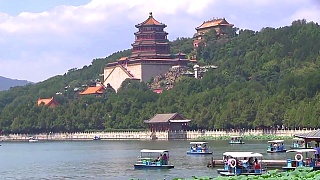
|
With Qingyunji ...
Fanjing Mountain, located in Tongren City, Guizhou Province, is a stunning natural and cultural landmark known for its unique landscapes, biodiversity, and spiritual significance. Here's a detailed overview of Fanjing Mountain:
### Location and Overview
- **Location**: Fanjing Mountain is situated in the Wuling Mountain range in Tongren City, northeastern Guizhou Province, China.
- **Elevation**: The highest peak of Fanjing Mountain reaches an elevation of 2,570 meters (8,430 feet) above sea level.
- **UNESCO World Heritage Site**: In 2018, Fanjing Mountain was designated a UNESCO World Heritage Site due to its rich biodiversity and unique geological features.
### Natural Beauty and Biodiversity
1. **Unique Geological Formations**: Fanjing Mountain is characterized by its distinctive rock formations, including the Red Cloud Golden Summit (HongYun JinDing), Mushroom Stone, and Old Golden Summit (LaoJinDing). These formations offer breathtaking views and are popular among photographers and nature enthusiasts.
2. **Biodiversity Hotspot**: The mountain is a biodiversity hotspot, home to numerous rare and endemic species. The area is particularly noted for its diverse plant life, including ancient ginkgo trees, fir forests, and a variety of medicinal herbs.
3. **Endangered Species**: Fanjing Mountain provides habitat for several endangered animal species, such as the Guizhou snub-nosed monkey (Rhinopithecus brelichi), Chinese giant salamander, and various rare birds and insects.
### Spiritual and Cultural Significance
1. **Buddhist Heritage**: Fanjing Mountain is one of the sacred Buddhist mountains in China. It is considered a place of enlightenment and has a long history of Buddhist worship. The mountain is associated with Maitreya Buddha (the future Buddha).
2. **Temples and Monasteries**: There are several ancient temples and monasteries on the mountain, including the Shizhong Temple and the Cheng’en Temple. These religious sites attract pilgrims and tourists alike, offering a peaceful and spiritual retreat.
3. **Pilgrimage Destination**: The mountain's spiritual significance makes it a popular pilgrimage destination for Buddhists, especially during religious festivals and important Buddhist dates.
### Tourist Attractions and Activities
1. **Hiking and Trekking**: Fanjing Mountain offers numerous hiking and trekking trails that cater to various levels of difficulty. The trails provide stunning views of the natural scenery and access to the mountain’s unique rock formations and temples.
2. **Cable Cars**: For those who prefer a less strenuous visit, cable cars are available to take visitors up to the scenic areas and major viewpoints, offering a comfortable and scenic ride.
3. **Panoramic Views**: The Golden Summit, one of the most famous peaks, offers panoramic views of the surrounding mountains and valleys. The sight of the sunrise and sunset from this vantage point is particularly spectacular.
4. **Photography**: The unique landscapes, diverse flora and fauna, and ancient temples make Fanjing Mountain a paradise for photographers.
### Conservation Efforts
1. **Protected Area**: Fanjing Mountain is part of a protected nature reserve, which helps to preserve its unique ecosystems and biodiversity.
2. **Sustainable Tourism**: Efforts are being made to promote sustainable tourism practices that minimize the impact on the natural environment and local communities while enhancing the visitor experience.
### Visitor Information
1. **Best Time to Visit**: The best time to visit Fanjing Mountain is during the spring (April to May) and autumn (September to October) when the weather is mild, and the natural scenery is at its most vibrant.
2. **Accessibility**: Fanjing Mountain can be accessed via Tongren, which is connected to major cities in China by train and air. From Tongren, visitors can take buses or taxis to the mountain’s entrance.
3. **Accommodation**: There are various accommodation options available, ranging from hotels in Tongren to guesthouses and inns near the mountain.
### Conclusion
Fanjing Mountain in Guizhou is a place of extraordinary natural beauty and cultural significance. With its unique geological formations, rich biodiversity, and profound spiritual heritage, it offers a diverse and enriching experience for nature lovers, hikers, pilgrims, and tourists. The mountain’s combination of stunning landscapes, rare wildlife, and ancient temples makes it a must-visit destination in China.
|
 The US empire, called ‘freedom and democracy’ – don’t miss it
The US empire, called ‘freedom and democracy’ – don’t miss it



